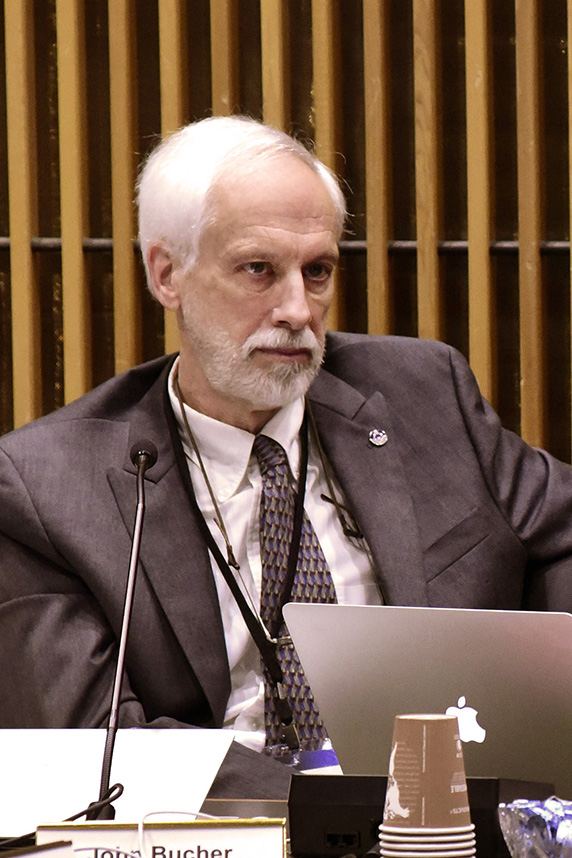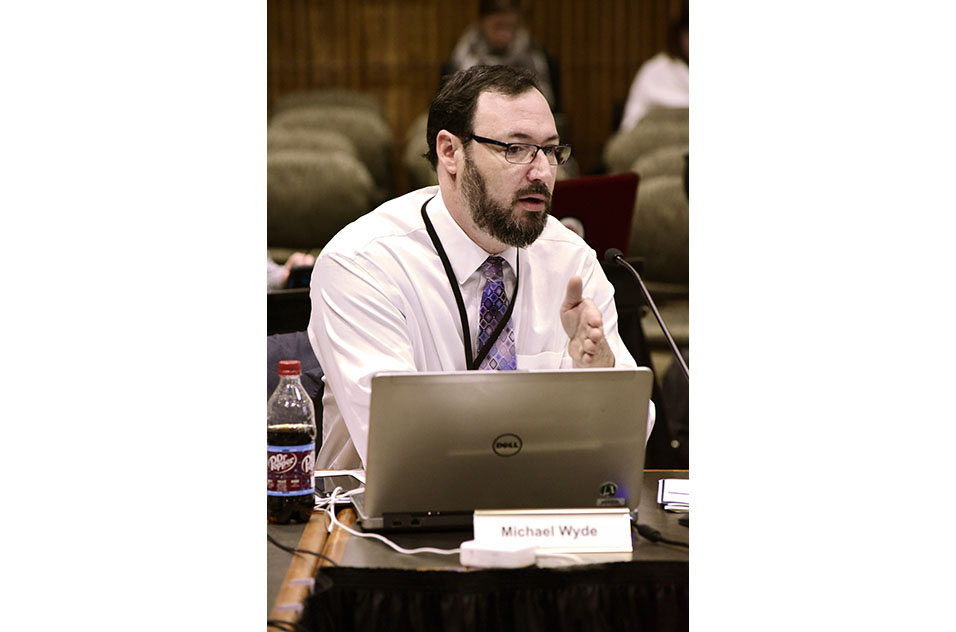NTP: altro passo concluso ! Le conclusioni determinano un CAMBIAMENTO
http://www.newsobserver.com/news/business/health-care/article207112454.html
Articolo dal New Observer . TRaduzione
Le onde radio a frequenza cellulare possono essere decisamente collegate al cancro nei ratti, secondo una riunione del comitato scientifico nazionale nel Research Triangle Park di mercoledì. La scoperta degli scienziati stabilisce la più chiara connessione del rischio di cellulare per gli esseri umani in un importante studio degli Stati Uniti fino ad oggi.
Gli scienziati hanno fatto il loro annuncio alla fine di una riunione di tre giorni per esaminare un esperimento sui roditori da 25 milioni di dollari condotto dal Programma nazionale di tossicologia in RTP per la Food and Drug Administration statunitense. La bozza dello studio, pubblicata all'inizio di febbraio, aveva in alcuni casi stabilito un legame debole e in alcuni casi nessun collegamento, ma il gruppo consultivo scientifico di mercoledì ha affermato che i dati sono più convincenti e indicano un rischio maggiore rispetto a quelli inizialmente riconosciuti.
Si prevede che la decisione di mercoledì cambierà il dibattito sulla sicurezza dei telefoni cellulari dato che l'industria delle telecomunicazioni, con l'incoraggiamento della Federal Communications Commission, si prepara a lanciare la tecnologia wireless 5G ad alta velocità di prossima generazione. Gli attivisti della salute pubblica prevedono che le conclusioni del panel scientifico sui rischi wireless aumenteranno la pressione sulle agenzie federali per emettere avvisi di sicurezza e stringere gli standard di sicurezza del dispositivo elettronico onnipresente.
"Probabilmente dovrebbe portare a una riduzione dei limiti di esposizione", ha detto Ronald Melnick, lo scienziato del National Toxicology Program che ha progettato lo studio prima di ritirarsi nove anni fa. "Questo è importante perché le agenzie che riceveranno questi dati prenderanno decisioni sulla salute pubblica sulla base di queste informazioni".
Melnick ha detto che i rischi per la salute riconosciuti mercoledì potrebbero costringere i funzionari pubblici e i leader delle telecomunicazioni "a non promuovere l'uso di alcuni di questi dispositivi a emissione di radiofrequenza per bambini".
Solo il mese scorso la bozza di rapporto era stata giudicata inconcludente dalla FDA e dall'American Cancer Society, e il gruppo scientifico era atteso dagli attivisti per apporre il timbro di approvazione a quelle conclusioni nella riunione di mercoledì.
Prima che gli scienziati votassero, Kevin Mottus, il direttore di outreach della California Brain Tumor Association, ha chiesto dal pavimento che l'intero panel si ricusasse per mancanza di qualifiche per valutare i dati di radiofrequenza. Mottus in seguito ha detto che i cellulari sono paragonabili all'amianto e al tabacco e dovrebbero contenere etichette di avvertimento.
Ma mentre la discussione elettorale ha preso il via, gli scienziati hanno iniziato a proporre mozioni per migliorare il livello dei risultati per affermare che un'esposizione prolungata alle radiofrequenze può essere chiaramente collegata al cancro del tessuto cardiaco nei ratti maschi. Il progetto di studio aveva precedentemente affermato che esisteva un collegamento ma nessuna evidenza chiara.
I tumori del tessuto cardiaco sono stati particolarmente significativi perché sono una rara forma di cancro che si verifica raramente nei ratti e non possono essere spiegati come malattie casuali.
John Bucher, scienziato senior del National Toxicology Program, ha affermato che il cancro del tessuto cardiaco che si sviluppa nei ratti maschi è lo stesso tipo di tumore che è stato osservato in alcune persone che hanno utilizzato per anni i cellulari nelle impostazioni di potenza più elevate.
"Il fatto che questo tipo di tumore fosse lo stesso ha attirato la nostra attenzione", ha detto Bucher. "E inoltre sono stati alcuni dei risultati più forti da un punto di vista numerico."
I relatori hanno anche votato che lo studio mostra alcuni collegamenti tra la radiazione del cellulare e il cancro al cervello nei ratti. Il progetto aveva affermato che il collegamento era equivoco, una designazione scientifica che indicava che era inconcludente e probabilmente irrilevante.
Oltre a mostrare un aumento dei tumori nei ratti, lo studio ha anche dimostrato che i ratti neonati pesavano meno e soffrivano di più alti tassi di mortalità quando vivevano in una camera di radiazione a radiofrequenza.
Qual'è il prossimo?
Il direttore della FDA dell'ufficio di scienza e ingegneria, Edward Margerrison, ha partecipato alla riunione e ha poi messo in guardia contro la formulazione di conclusioni avventate basate sulle votazioni di mercoledì. "Stiamo adottando un approccio responsabile", ha detto. "Non andiamo a prendere decisioni impulsive"
La FDA tradurrà i risultati dei roditori in rischi per la salute umana e la Commissione federale delle comunicazioni deciderà se le conclusioni della FDA sono abbastanza serie da giustificare l'introduzione di standard di emissioni inferiori per i cellulari degli Stati Uniti o di adottare altre precauzioni.
--------------------------------------------------------------------------------------------
articolo con riscontro di dettaglio della commissione degli esperti e voti
https://www.saferemr.com/2018/01/national-toxicology-program-peer-public.html
----------------------------------------------------------------------------------------------------------
NTP should conduct these analyses controlling for differences in survival between the exposed and control animals.
http://www.saferemr.com/2018/0
--
Eleven experts convened by the National Toxicology Program (NTP) over a three day period to review the draft technical reports from the NTP's cell phone radiation studies concluded that there is "clear evidence" that exposure to cell phone radiation caused a rare cancer in the hearts of male rats, and there is "equivocal evidence" for the hearts of female rats.
The expert panel also reported "some evidence" that cell phone radiation exposure caused brain cancer in male and female rats and cancer of the adrenal glands in male rats. Additionally, "equivocal evidence" of cancer risk was reported in the pituitary, adrenal, and prostate glands and pancreas and liver in male rats and adrenal glands in female rats.
The mice in the study, exposed to a different cell phone radiation frequency than the rats (1800 MHz vs. 900 MHz), displayed less evidence of cancer risk. Equivocal evidence of cancer risk from cell phone radiation was reported for lymphoma in male and female mice. Equivocal evidence was also reported for skin, lung, and liver cancer in male mice.
In seven instances, the expert group upgraded the evaluations of evidence published by NTP staff in the draft technical reports. Thus, the NTP scientists appear to have been overly conservative in their assessment of the hazards of long-term exposure to cell phone radiation.
A table (dated March 30) based upon NTP's official results which compares the evaluations of evidence of carcinogenicity prepared by NTP staff with the expert committee's findings can be found at:
--
 Bucher cautioned that the findings tell us that we should take a closer look, but they should not be directly extrapolated to human cell phone usage. (Photo courtesy of Steve McCaw)
Bucher cautioned that the findings tell us that we should take a closer look, but they should not be directly extrapolated to human cell phone usage. (Photo courtesy of Steve McCaw)
 Panel chair David Eaton, Ph.D., of the University of Washington, said NTP was clairvoyant for including in utero exposure long before this was commonly considered in toxicology. (Photo courtesy of Steve McCaw)
Panel chair David Eaton, Ph.D., of the University of Washington, said NTP was clairvoyant for including in utero exposure long before this was commonly considered in toxicology. (Photo courtesy of Steve McCaw)
 Blystone oversaw internal scientific reviews with NTP staff. (Photo courtesy of Steve McCaw)
Blystone oversaw internal scientific reviews with NTP staff. (Photo courtesy of Steve McCaw)
 From right, John Ladbury of the National Institute of Standards and Technology, Kuster, and Capstick presented the exposure system and how it was validated. (Photo courtesy of Steve McCaw)
From right, John Ladbury of the National Institute of Standards and Technology, Kuster, and Capstick presented the exposure system and how it was validated. (Photo courtesy of Steve McCaw)
https://factor.niehs.nih.gov/2018/4/feature/feature-2-cell-phone/index.htm
--
Male rats exposed to cell phone radiation were significantly more likely to develop tumors and cancer
Null hypothesis rejected
Also see:
National Toxicology Program Finds Cell Phone Radiation Causes Cancer
Ramazzini Institute Replicates Key Finding from NTP Study
--
Articolo dal New Observer . TRaduzione
Le onde radio a frequenza cellulare possono essere decisamente collegate al cancro nei ratti, secondo una riunione del comitato scientifico nazionale nel Research Triangle Park di mercoledì. La scoperta degli scienziati stabilisce la più chiara connessione del rischio di cellulare per gli esseri umani in un importante studio degli Stati Uniti fino ad oggi.
Gli scienziati hanno fatto il loro annuncio alla fine di una riunione di tre giorni per esaminare un esperimento sui roditori da 25 milioni di dollari condotto dal Programma nazionale di tossicologia in RTP per la Food and Drug Administration statunitense. La bozza dello studio, pubblicata all'inizio di febbraio, aveva in alcuni casi stabilito un legame debole e in alcuni casi nessun collegamento, ma il gruppo consultivo scientifico di mercoledì ha affermato che i dati sono più convincenti e indicano un rischio maggiore rispetto a quelli inizialmente riconosciuti.
Si prevede che la decisione di mercoledì cambierà il dibattito sulla sicurezza dei telefoni cellulari dato che l'industria delle telecomunicazioni, con l'incoraggiamento della Federal Communications Commission, si prepara a lanciare la tecnologia wireless 5G ad alta velocità di prossima generazione. Gli attivisti della salute pubblica prevedono che le conclusioni del panel scientifico sui rischi wireless aumenteranno la pressione sulle agenzie federali per emettere avvisi di sicurezza e stringere gli standard di sicurezza del dispositivo elettronico onnipresente.
"Probabilmente dovrebbe portare a una riduzione dei limiti di esposizione", ha detto Ronald Melnick, lo scienziato del National Toxicology Program che ha progettato lo studio prima di ritirarsi nove anni fa. "Questo è importante perché le agenzie che riceveranno questi dati prenderanno decisioni sulla salute pubblica sulla base di queste informazioni".
Melnick ha detto che i rischi per la salute riconosciuti mercoledì potrebbero costringere i funzionari pubblici e i leader delle telecomunicazioni "a non promuovere l'uso di alcuni di questi dispositivi a emissione di radiofrequenza per bambini".
Solo il mese scorso la bozza di rapporto era stata giudicata inconcludente dalla FDA e dall'American Cancer Society, e il gruppo scientifico era atteso dagli attivisti per apporre il timbro di approvazione a quelle conclusioni nella riunione di mercoledì.
Prima che gli scienziati votassero, Kevin Mottus, il direttore di outreach della California Brain Tumor Association, ha chiesto dal pavimento che l'intero panel si ricusasse per mancanza di qualifiche per valutare i dati di radiofrequenza. Mottus in seguito ha detto che i cellulari sono paragonabili all'amianto e al tabacco e dovrebbero contenere etichette di avvertimento.
Ma mentre la discussione elettorale ha preso il via, gli scienziati hanno iniziato a proporre mozioni per migliorare il livello dei risultati per affermare che un'esposizione prolungata alle radiofrequenze può essere chiaramente collegata al cancro del tessuto cardiaco nei ratti maschi. Il progetto di studio aveva precedentemente affermato che esisteva un collegamento ma nessuna evidenza chiara.
I tumori del tessuto cardiaco sono stati particolarmente significativi perché sono una rara forma di cancro che si verifica raramente nei ratti e non possono essere spiegati come malattie casuali.
John Bucher, scienziato senior del National Toxicology Program, ha affermato che il cancro del tessuto cardiaco che si sviluppa nei ratti maschi è lo stesso tipo di tumore che è stato osservato in alcune persone che hanno utilizzato per anni i cellulari nelle impostazioni di potenza più elevate.
"Il fatto che questo tipo di tumore fosse lo stesso ha attirato la nostra attenzione", ha detto Bucher. "E inoltre sono stati alcuni dei risultati più forti da un punto di vista numerico."
I relatori hanno anche votato che lo studio mostra alcuni collegamenti tra la radiazione del cellulare e il cancro al cervello nei ratti. Il progetto aveva affermato che il collegamento era equivoco, una designazione scientifica che indicava che era inconcludente e probabilmente irrilevante.
Oltre a mostrare un aumento dei tumori nei ratti, lo studio ha anche dimostrato che i ratti neonati pesavano meno e soffrivano di più alti tassi di mortalità quando vivevano in una camera di radiazione a radiofrequenza.
Qual'è il prossimo?
Il direttore della FDA dell'ufficio di scienza e ingegneria, Edward Margerrison, ha partecipato alla riunione e ha poi messo in guardia contro la formulazione di conclusioni avventate basate sulle votazioni di mercoledì. "Stiamo adottando un approccio responsabile", ha detto. "Non andiamo a prendere decisioni impulsive"
La FDA tradurrà i risultati dei roditori in rischi per la salute umana e la Commissione federale delle comunicazioni deciderà se le conclusioni della FDA sono abbastanza serie da giustificare l'introduzione di standard di emissioni inferiori per i cellulari degli Stati Uniti o di adottare altre precauzioni.
--------------------------------------------------------------------------------------------
articolo con riscontro di dettaglio della commissione degli esperti e voti
https://www.saferemr.com/2018/01/national-toxicology-program-peer-public.html
----------------------------------------------------------------------------------------------------------
NTP Should Analyze Overall Tumor Risk in Cell Phone Radiation Studies
Electromagnetic Radiation Safety, March 30, 2018
In my written submission to NTP about the cell phone radiation studies, I recommended that NTP analyze the overall tumor risk from cell phone radiation exposure. After watching the three-day expert review of these studies, I restate this recommendation.
While it is useful to examine what happened to the trees in the forest in this experiment (e.g., the increased risk of a specific tumor developing in male rats from GSM exposure), it is essential to examine what happened to the forest (e.g., the overall risk of a male rat developing a malignant tumor from exposure to cell phone radiation).
NTP should test the null hypothesis that lifelong exposure to non-thermal levels of cell phone radiation does not increase the incidence of cancer.
NTP should test the null hypothesis that lifelong exposure to non-thermal levels of cell phone radiation does not increase the incidence of cancer.
There are several strong justifications for conducting this analysis.
First, a 5-year, $5 million Air Force study found low incidences of various types of tumors in male rats exposed to microwave radiation. In that study, the exposed rats were three times more likely to get cancer than the control rats. The study employed much lower intensity microwave radiation than the NTP studies.
Second, early toxicology research on the effects of tobacco found low incidences of many types of tumors among animals exposed to tobacco smoke. Scientists dismissed this evidence as they assumed an agent could not cause cancer in different types of tissue. History later proved them wrong.
Third, numerous biologic studies have found that exposure to low-intensity radiofrequency radiation increases oxidative stress causing generation of free radicals, stress proteins, and DNA damage in many different types of cells.
Finally, my preliminary analysis of the overall tumor risk using summary data from the appendices to the NTP report, found that male rats exposed to cell phone radiation were significantly more likely to develop cancer than control rats (38% vs. 25.5%; p = .021), and more likely to develop a nonmalignant tumor (70% vs. 54%; p = .003).
Male rats in the lowest cell phone radiation exposure group, 1.5 watts per kilogram, were also more likely to develop a nonmalignant tumor than control rats (74% vs. 54%; p < .001). Although cancer incidence for this low exposure group was greater than the control group, the difference was not statistically significant (34% vs. 25.5%; p = .163).
NTP should conduct these analyses controlling for differences in survival between the exposed and control animals.
http://www.saferemr.com/2018/0
--
Experts find "clear evidence" of cancer from cell phone radiation in NTP study
Electromagnetic Radiation Safety, March 28, 2018 (UPDATED March 30)
Electromagnetic Radiation Safety, March 28, 2018 (UPDATED March 30)
Eleven experts convened by the National Toxicology Program (NTP) over a three day period to review the draft technical reports from the NTP's cell phone radiation studies concluded that there is "clear evidence" that exposure to cell phone radiation caused a rare cancer in the hearts of male rats, and there is "equivocal evidence" for the hearts of female rats.
A table (dated March 30) based upon NTP's official results which compares the evaluations of evidence of carcinogenicity prepared by NTP staff with the expert committee's findings can be found at:
More Information:
National Toxicology Program Finds Cell Phone Radiation Causes Cancer
Ramazzini Institute Cell Phone Radiation Study Replicates NTP Study
National Toxicology Program Finds Cell Phone Radiation Causes Cancer
Ramazzini Institute Cell Phone Radiation Study Replicates NTP Study
General Interest:
By Mark Hertsgaard and Mark Dowie,THE NATION, March 29, 2018.
--
NTP cell phone studies — experts recommend elevated conclusions
By Virginia Guidry, Environmental Factors/NIEHS Online News, April 2018
 Bucher cautioned that the findings tell us that we should take a closer look, but they should not be directly extrapolated to human cell phone usage. (Photo courtesy of Steve McCaw)
Bucher cautioned that the findings tell us that we should take a closer look, but they should not be directly extrapolated to human cell phone usage. (Photo courtesy of Steve McCaw)
A panel of external scientific experts met March 26-28 at NIEHS and recommended that some National Toxicology Program (NTP) conclusions be changed to indicate stronger levels of evidence that cell phone radiofrequency radiation (RFR) caused tumors in rats.
The panel agreed with NTP conclusions that there was little indication of RFR-related health problems in mice. The panel reviewed the conclusions of two draft technical reports, one in rats and one in mice, based on 10 years and $25 million of research.
“It was gratifying that the members of the expert panel unanimously praised the NTP cell phone studies as very well done, and vitally important research,” said NTP Senior Scientist John Bucher, Ph.D. “They conducted a thorough review, engaged in spirited debate, and grappled with the same uncertainties as did the NTP staff.”
Bucher stressed that the goal of the study was to establish the potential health hazard of exposure to cell phone RFR. He said that to detect a potential effect, the rodents’ whole bodies were exposed to levels equal to and higher than the highest level permitted for local tissue exposure in cell phone emissions today.
 Panel chair David Eaton, Ph.D., of the University of Washington, said NTP was clairvoyant for including in utero exposure long before this was commonly considered in toxicology. (Photo courtesy of Steve McCaw)
Panel chair David Eaton, Ph.D., of the University of Washington, said NTP was clairvoyant for including in utero exposure long before this was commonly considered in toxicology. (Photo courtesy of Steve McCaw)Heart, brain, and adrenal tumors
Working from the NTP scale of clear evidence, which is graded as some evidence, equivocal evidence, and no evidence, the panel made several recommendations.
The experts recommended that tumors in tissues surrounding nerves in the hearts of male rats, called malignant schwannomas, be reclassified from some evidence to clear evidence of carcinogenic activity.
In female rats, they recommended reclassification of malignant schwannomas from no evidence to equivocal evidence of carcinogenic activity. The panel agreed that there were unusual patterns of cardiomyopathy, or damage to heart tissue, in exposed male and female rats.
“When I look at these types of studies, I look for high-level signals that can infer mechanisms. I have more questions than answers, but the heart is clearly sending a signal in the rat studies, between the levels of cardiomyopathy and malignant tumors,” said panelist Rick Adler, D.V.M., Ph.D., senior director of discovery and regulatory pathology for GlaxoSmithKline.
The panel recommended that findings for a type of brain tumor, called malignant glioma, and a tumor in the adrenal gland, called pheochromocytoma, be reclassified as some evidence of carcinogenic activity in male rats.
Tissue changes and lower body weights
 Blystone oversaw internal scientific reviews with NTP staff. (Photo courtesy of Steve McCaw)
Blystone oversaw internal scientific reviews with NTP staff. (Photo courtesy of Steve McCaw)
NTP researchers also looked for noncancerous health effects in rats and mice. The panel agreed that there were increases in damage to brain tissue in exposed male and female rats, which further supported the classifications of cancerous effects in the brain.
For several other tissues, including the prostate and pituitary glands, the panel agreed that tissue changes were equivocal, meaning it was unclear if any of these tumor increases were related to RFR.
NTP also reported lower body weights among newborn rats and their mothers, especially when exposed to high levels of RFR during pregnancy and lactation, but these animals later grew to normal size.
“I want to highlight that we don’t rely on one specific item for determining response,” said NTP toxicologist Chad Blystone, Ph.D. He explained that NTP staff review numerous factors when determining conclusions, including those listed below.
- Statistics.
- Dose-response relationship.
- Commonality of tumors and tissue changes.
- Comparison to concurrent and historical controls.
- Findings across sexes and species.
Most expensive, technically challenging studies
To conduct the studies, NTP worked with collaborators at the IT’IS Foundation to design special chambers that exposed rats and mice to different levels of RFR for up to two years, including exposure to pups while in the womb.
Myles Capstick, Ph.D., of the IT’IS Foundation explained that they wanted to expose the whole animals because they were not sure where health effects might occur. “We were aiming to expose as many tissues as possible, not mimic a phone next to the head,” said Capstick.
 From right, John Ladbury of the National Institute of Standards and Technology, Kuster, and Capstick presented the exposure system and how it was validated. (Photo courtesy of Steve McCaw)
From right, John Ladbury of the National Institute of Standards and Technology, Kuster, and Capstick presented the exposure system and how it was validated. (Photo courtesy of Steve McCaw)
Exposure levels ranged from 1.5 to 6 watts per kilogram in rats and 2.5 to 10 watts per kilogram in mice. The low power level for rats was equal to the highest level permitted for local tissue exposures to cell phone emissions today. The animals were exposed for 10-minute on, 10-minute off cycles that totaled more than 9 hours each day.
The studies used 2G and 3G frequencies and modulations that are still used in voice calls and texting in the United States. More recent 4G, 4G-LTE, and 5G networks for streaming video and downloading attachments use different cell phone signal frequencies and modulations than NTP used in these studies. Niels Kuster, Ph.D., of the IT’IS Foundation added that their studies of 4G technologies are very similar.
There were approximately 3,000 animals in the study, and pathologists examined 50 tissues in each animal to look for signs of cancer or other changes.
(Virginia Guidry, Ph.D., is a technical writer and public information specialist in the NIEHS Office of Communications and Public Liaison and a regular contributor to the Environmental Factor.)
Asimina Kiourti, Ph.D., of the Ohio State University, acknowledged the challenge of changing technology. “How to catch up with technology?” she said. “This study delivered 100 percent of what you promised.” (Image courtesy of Steve McCaw)
https://factor.niehs.nih.gov/2018/4/feature/feature-2-cell-phone/index.htm
--
Male rats exposed to cell phone radiation were significantly more likely to develop tumors and cancer
Null hypothesis rejected
Electromagnetic Radiation Safety, March 30, 2018 (Updated April 2)
... my preliminary analysis of the overall tumor risk using summary data from the appendices to the NTP report, found that male rats exposed to cell phone radiation were significantly more likely to develop a tumor than control rats overall (81% vs. 62%; p < .001), and even in the lowest cell phone radiation exposure group, 1.5 watts per kilogram (82% vs. 62%; p <.001).
Male rats exposed to cell phone radiation were significantly more likely to develop cancer than control rats (38% vs. 26%; p = .021), and more likely to develop a nonmalignant tumor (70% vs. 54%; p = .003).
Male rats in the lowest cell phone radiation exposure group, 1.5 watts per kilogram, were also more likely to develop a nonmalignant tumor than control rats (74% vs. 54%; p < .001). Although cancer incidence for this low exposure group was greater than the control group, the difference was not statistically significant (34% vs. 26%; p = .163).
NTP should conduct these analyses controlling for survival differences between the exposed and control animals.
National Toxicology Program: Peer & public review
National Toxicology Program: Peer & public review
National Toxicology Program Finds Cell Phone Radiation Causes Cancer
Ramazzini Institute Replicates Key Finding from NTP Study
--
Joel M. Moskowitz, Ph.D., Director
Center for Family and Community Health
School of Public Health
University of California, Berkeley
Center for Family and Community Health
School of Public Health
University of California, Berkeley





Commenti
Posta un commento